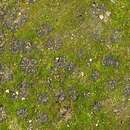More info for the terms:
climax,
cover,
formation,
grassland,
lichen,
lichens,
naturalCryptogamic soil crusts, including crusts formed by soil jelly lichen, are an
important component of many arid rangeland ecosystems in the western
United States [
17]. Where cryptogam crusts are highly developed, the
soil surface is almost always highly stable [
8]. They are important in
the reduction of soil erosion, and facilitate vascular plant seedling
establishment by improving water penetration and reducing runoff
[
17,
18]. Components that are capable of nitrogen fixation, such as C.
tenax, contribute a significant amount to the total soil nitrogen,
especially in arid soils [
21,
29]. Soils having high electrical
conductivity, high phosphorous, and high salt contents facilitate the
formation of cryptogam crusts [
3]. Heavy grazing, especially during
seasons of low precipitation, high temperatures, and persistent winds
can seriously damage or destroy crusts formed by soil jelly lichen and other
cryptogams. During these seasons, soil jelly lichen is usually dormant and
brittle, and susceptible to trampling by livestock [
4]. Vascular plant
communities may appear well managed and healthy, while cryptogamic crusts
are being severely disturbed. Managers of arid lands should be cautious
about accepting sparse cryptogamic cover as natural [
20]. Cryptogam
analysis can be useful in evaluating the quality of grassland management
[
21]. In Navaho National Monument, Arizona, soil jelly lichen was reduced from
0.8 percent cover in ungrazed areas to 0.4 percent cover in heavily
grazed areas. Although its cover was reduced, soil jelly lichen did not react to
grazing pressure as severely as other cryptogams in the study area [
8].
Cryptogamic soil crusts, including crusts formed by soil jelly lichen, are an
important component of many arid rangeland ecosystems in the western
United States [
17]. Where cryptogam crusts are highly developed, the
soil surface is almost always highly stable [
8]. They are important in
the reduction of soil erosion, and facilitate vascular plant seedling
establishment by improving water penetration and reducing runoff
[
17,
18]. Components such as soil jelly lichen that are capable of nitrogen
fixation contribute a significant amount to the total soil nitrogen,
especially in arid soils [
21,
29]. Soils having high electrical
conductivity, high phosphorous, and high salt contents facilitate the
formation of cryptogam crusts [
3]. Heavy grazing, especially during
seasons of low precipitation, high temperatures, and persistent winds
can seriously damage or destroy crusts formed by soil jelly lichen and other
cryptogams. During these seasons, soil jelly lichen is usually dormant and
brittle, and susceptible to trampling by livestock [
4]. Vascular plant
communities may appear well managed and healthy while cryptogamic crusts
are being severely disturbed. Managers of arid lands should be cautious
about accepting sparse cryptogamic cover as natural [
20]. Cryptogam
analysis can be useful in evaluating the quality of grassland management
[
21]. In Navaho National Monument, Arizona, soil jelly lichen was reduced from
0.8 percent cover in ungrazed areas to 0.4 percent cover in heavily
grazed areas. Although its cover was reduced, soil jelly lichen did not react to
grazing pressure as severely as other cryptogams in the study area [
8].
In Utah, cryptogam crusts recovered from grazing within 14 to 17 years
after grazing was eliminated [
4]. Soil jelly lichen recovers rapidly from
grazing [
31].
In semiarid and arid grasslands of Canyonlands National Park, Utah,
cryptogams, including soil jelly lichen, are instrumental in the build-up of
organic matter and soil nutrients. Cryptogam cover stabilizes soils
eroded by heavy winds and torrential rains, especially in undisturbed
areas [
21]. Relative abundance of soil jelly lichen was "significantly" less in
formerly grazed areas compared to areas of undisturbed climax
grasslands. The ungrazed areas of the park had an average of six
cryptogam species per site, with total cryptogram coverage of 38
percent. The disturbed or formerly grazed areas had an average of two
cryptogam species per site, with a total coverage of 5 percent. This
difference suggests that cryptogam species such as soil jelly lichen may play a
more important role in the stability of desert grasslands than
previously recognized. The formerly grazed areas had less organic
matter, less available phosphorous, and higher calcium content of
surface soils due to slow sheet erosion due to lack of protection from
an established cryptogam cover [
20].
Lichens are widely used as indicators of air pollution or air quality.
These poikilohydric plants are extremely sensitive to atmospheric
contaminants, especially sulfur dioxide, because they absorb moisture as
water vapor. Nitrogenase activity and photosynthetic rates of soil jelly lichen
are severely inhibited by sulfur dioxide. Nitrogen fixation is reduced
at fluoride and lead concentrations as low as 0.01 parts per million.
When soil jelly lichen and other nitrogen-fixing lichens are abundant in
nitrogen-poor grassland soils, any loss of fixed nitrogen due to
reduction of fixation rates by contaminants would probably reduce yields
of rangeland grasses [
29].

